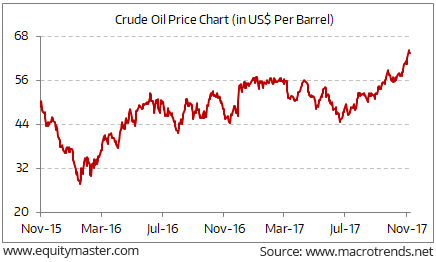- Home
- Todays Market
- Indian Stock Market News April 18, 2018
Indian Indices Trade Marginally Higher; FMCG Sector Up 2% Wed, 18 Apr 12:30 pm
Stock markets in India are presently trading marginally higher. Sectoral indices are trading on a mixed note with stocks in the FMCG sector and realty sector witnessing maximum buying interest.
The BSE Sensex is trading up 60 points (up 0.2%) and the NSE Nifty is trading up 15 points (up 0.1%). The BSE Mid Cap index is trading up by 0.2%, while the BSE Small Cap index is trading up by 0.1%. The rupee is trading at 65.70 to the US$.
Vedanta share price and Electrosteel Steels share price are in focus today as the National Company Law Tribunal's (NCLT) Kolkata bench approved a Rs 53 billion resolution plan for Electrosteel Steels.
The development paves the way for acquisition of Electrosteel Steels by the local unit of London-visited Vedanta Resources.
As per the news, the deal requires formal clearance from the Competition Commission of India and the Securities and Exchange Board of India, which is likely in the next couple of months.
Note the Electrosteel Steels was the first of the big defaulters to emerge from bankruptcy proceedings.
At the time of writing, Vedanta share price was trading up by 1.5%, while Electrosteel Steels share price was trading down by 5%.
In the news from currency markets, the rupee is witnessing selling pressure today and has hit a fresh 7-month low against the dollar. The rupee depreciation is seen on the back of worsening trade scenario and a fresh ripple of geopolitical tensions.
Who will feel the pain of the falling rupee?
A depreciation in rupee means importers buying goods and services at a higher rate that earlier. This doesn't bode well for a developing economy that relies heavily on imports.
Also, India imports most of its oil requirements. A rise in the dollar leads to a consequent rise in the import bill.
On the corporate side, companies who have taken foreign loans from abroad will be impacted. The repayment obligations in terms of principal and interest will rise, leading to a dent in the cash flows and financials.
Further, companies who import a majority of their raw material requirements will get impacted provided they have not hedged their foreign currency exposure.
Looking at the brighter side, rupee depreciation brings a cheer on the exports front.
A depreciating rupee will provide a much-needed cushion to falling exports. However, a falling rupee will not be the only factor to boost exports. There are certain structural issues too; the government needs to address to get the exports back on track.
Going forward, we won't be surprised if the rupee breaches the 70 levels. Provided the depreciation comes at a measured pace, long-term investors should not fret about the same. The RBI has enough foreign exchange reserves as a buffer to stabilize the rupee in case of a freefall.
In the news from commodity markets, crude oil is witnessing buying interest today. Gains are seen on the back of a reported fall in US crude inventories and the ongoing risk of supply disruptions.
Last week too, the commodity was headed for its biggest weekly advance in more than eight months on speculation that tensions in the Middle East may lead to supply disruptions, reinforcing a buy call on commodities by Goldman Sachs Group Inc.
The risk of conflict in Syria, as well as ongoing tensions between Saudi Arabia and Iranian-backed rebels in Yemen, has raised concerns over supply security in the energy-rich region.
While OPEC said its output last month fell to the lowest in a year, with worldwide inventories set to decline significantly later this year, the International Energy Agency (IEA) sees a second wave of shale revolution in the US.
How this pans out remains to be seen. We will keep you updated on all the developments from this space.
Note that crude oil prices have been witnessing a rising trend of late. It hit its 28-month high level in November, as can be seen from the chart below, and is trading at similar levels presently.
Crude Oil Hits 28-Month High
However, this is not good news from India's perspective.
As we wrote in a recent edition of The 5 Minute WrapUp...
- Fiscal revenues are at risk. Particularly if the government is forced to consider a cut in fuel excise duties due to a rally in oil prices. In recent times, a sharp jump in excise collections has helped indirect tax collections. Any risk to revenues and subsequent threat to the fiscal deficit target at 3.2% of GDP would require tighter spending cuts.
Secondly, the impact on inflation needs to be monitored. This narrowing the central bank's scope for further rate cuts.
Lastly, low crude prices were a positive growth impetus through higher discretionary incomes for households and lower input costs for manufacturers and farmers. Part of this benefit is likely to be eroded as retail fuel costs rise. As for corporations, expansion in gross margins caused by falling commodity prices is also likely to wane, pressurising profitability.
You can read the entire article here.
For information on how to pick stocks that have the potential to deliver big returns, download our special report now!
Read the latest Market Commentary



Equitymaster requests your view! Post a comment on "Indian Indices Trade Marginally Higher; FMCG Sector Up 2%". Click here!
Comments are moderated by Equitymaster, in accordance with the Terms of Use, and may not appear
on this article until they have been reviewed and deemed appropriate for posting.
In the meantime, you may want to share this article with your friends!